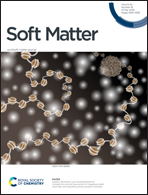Diffusion behavior of peptide amphiphiles containing different numbers of alkyl tails at a hydrophobic solid–liquid interface: single molecule tracking investigation†
Abstract
Using the single molecule tracking technique, the diffusion behavior of peptide amphiphiles (PAs) with different numbers of alkyl tails at a hydrophobic solid–liquid interface has been investigated. The effect of the number of alkyl tails of PAs on molecular trajectories at the hydrophobic solid–liquid interface has been systematically studied. PA molecules display an intermittent motion consisting of immobilization and hopping processes, which has been well simulated by the continuous time random walk (CTRW) model. The results reveal that the hydrophobic interaction between the PAs and hydrophobic surface plays an important role in the diffusion behavior of PAs. Increasing the number of alkyl tails in PAs systematically reduces the mobility of PAs on the hydrophobic surface. Moreover, the diffusion behavior of PAs at the hydrophobic interface also shows pH dependence. A decrease in pH is beneficial to the motion of all PAs on the hydrophobic surface, which can be ascribed to the protonation of PAs in acidic solutions. Therefore, the hydrophobic interaction is crucial to the transport of peptide amphiphiles at hydrophobic interfaces which would be important for the design of peptides in biological applications.



 Please wait while we load your content...
Please wait while we load your content...